June 1 Exploring Chios (Day 248)

Dawn over the mountains of Turkey! That’s how close the island of Chios is to Turkey!
After breakfast we walked to the port and collected the car we reserved yesterday for our all day tour of the south of the island.
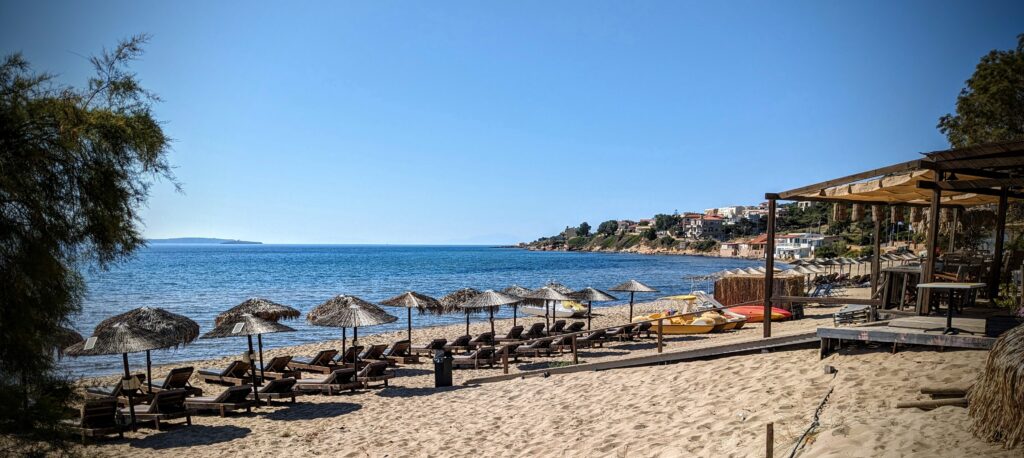
Our first stop, at the first beach we came to, for coffees and relaxing on the deck over the sand.
Our next stop was a monastery up in the hills.

Looking through the doors of the walled monastery at the unique Greek tiled walkway using contrasting black and brown pebbles. The central church, surrounded by monastic cells built along the outer walls.
We entered the small museum on the right of the church and learned some very sobering history!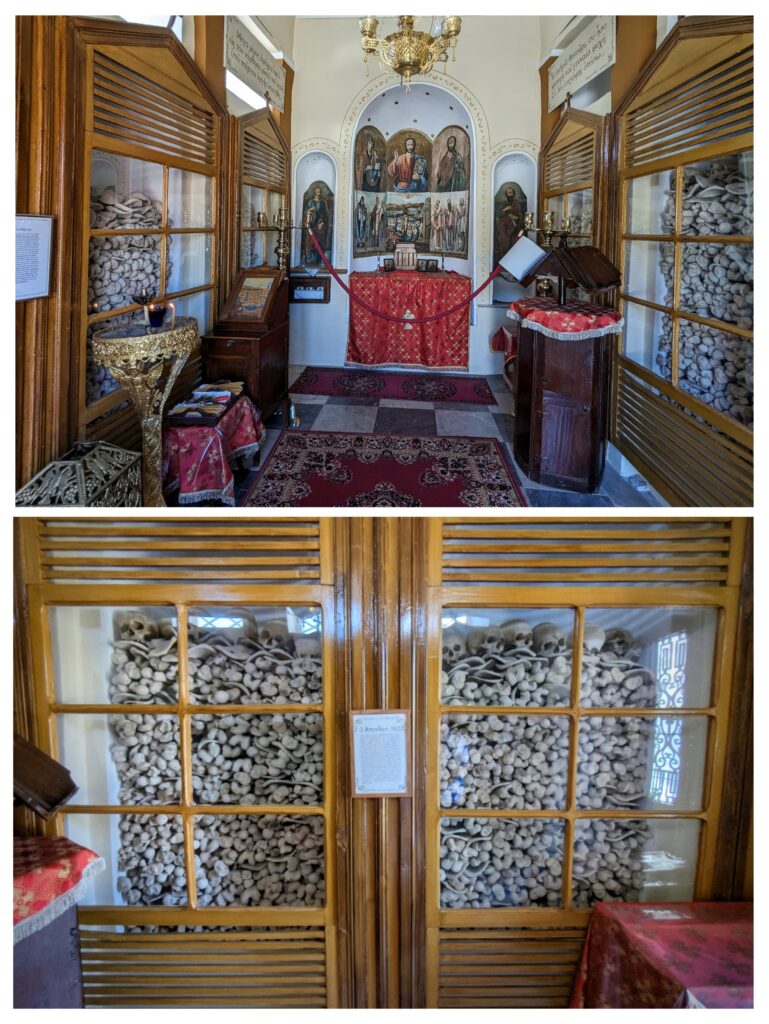 The museum is the ossuary of the bones of some of the victims of the Massacre of Chios, a pivotal point in the Greek War of Independence of 1821-29. At least 25,000 people were killed by the invading Ottoman Turks, and about twice as many were enslaved, with 10 to 20,000 escaped, over the course of several months in March and April of 1822. On April 2, 1822 the Turks attacked this area and mostly women and children fled to the monastery for protection.
The museum is the ossuary of the bones of some of the victims of the Massacre of Chios, a pivotal point in the Greek War of Independence of 1821-29. At least 25,000 people were killed by the invading Ottoman Turks, and about twice as many were enslaved, with 10 to 20,000 escaped, over the course of several months in March and April of 1822. On April 2, 1822 the Turks attacked this area and mostly women and children fled to the monastery for protection.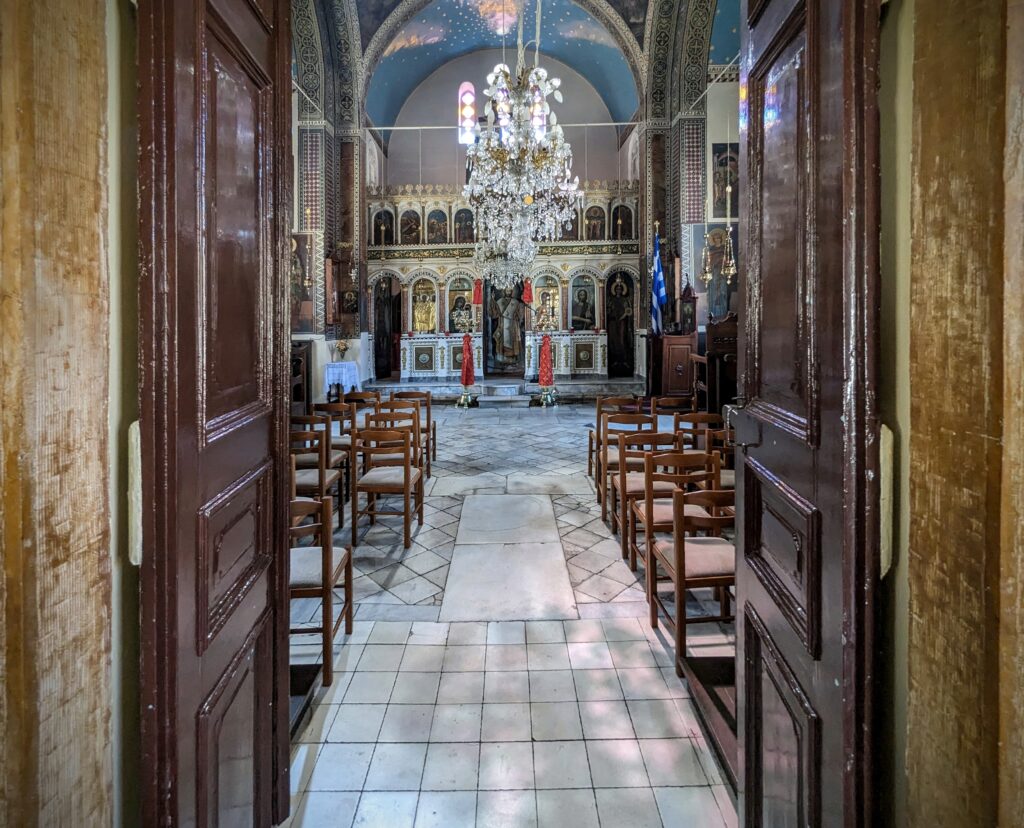 The Turks attacked the church and burned it to the ground with all inside. The floor is the only original part of the church and is said to be stained with the blood and flesh of the victims burned alive.
The Turks attacked the church and burned it to the ground with all inside. The floor is the only original part of the church and is said to be stained with the blood and flesh of the victims burned alive.
The global outrage at the violence helped the Greek solidify their revolt against the Ottoman Empire, gain foreign allies and turn the tide eventually. We sought out a more peaceful venue after that history lesson!
We sought out a more peaceful venue after that history lesson!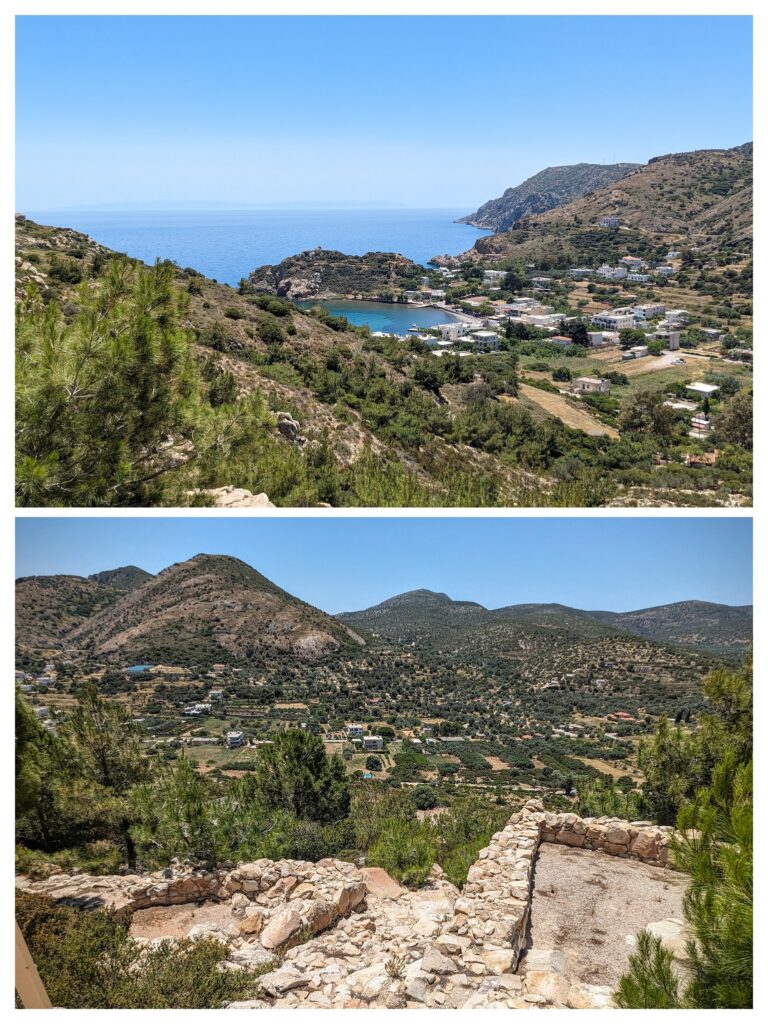 We continued to a more ancient site at Emporio, an archaeological site dating from the 8th century B.C. overlooking the small port. The cultivated fields are mostly orchards of mastic trees, a unique agricultural phenomenon practiced only on the south part of Chios island. We continued south, to the southernmost beach, Vroulidia (or Broulidia, depends on what map you’re looking at I guess).
We continued to a more ancient site at Emporio, an archaeological site dating from the 8th century B.C. overlooking the small port. The cultivated fields are mostly orchards of mastic trees, a unique agricultural phenomenon practiced only on the south part of Chios island. We continued south, to the southernmost beach, Vroulidia (or Broulidia, depends on what map you’re looking at I guess).
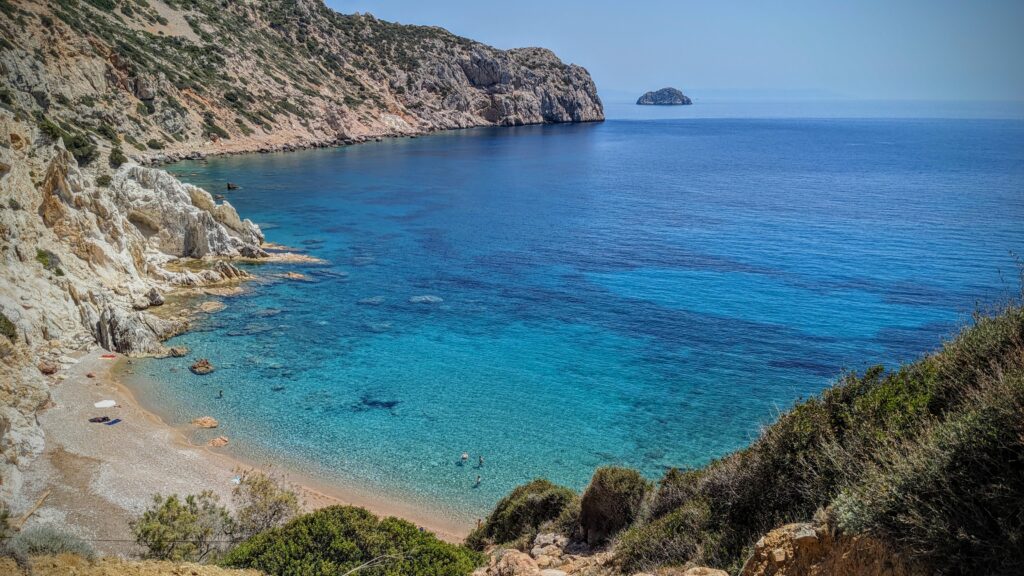
A steep walk down to this beautiful beach with crystal clear water dissuaded us, especially since there was a rustic bar in the shade up top!

The bar/restaurant had a great sales method, a dumbwaiter cable to retrieve orders from the beach and send the orders down!
From the bar, refreshed with a cold brew, we drove north to the Mastic Museum to learn more about this unique Chios product.

Mastic production has been going on for centuries. The many villages have each cultivated their own varieties of the shrub, but the production methods have remained the same through history.
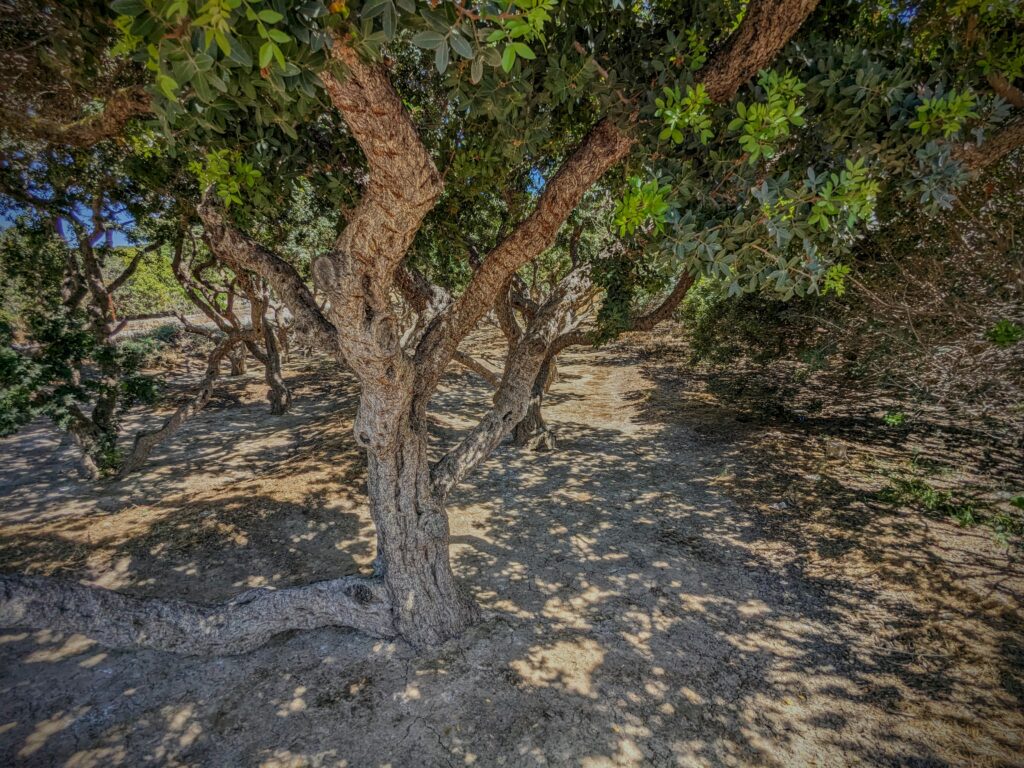
A close up of a mastic tree in an orchard, if you look closely you can see horizontal cuts on the bark from which the resin oozes to be collected, dried and cleaned with labor intensive methods.

As we turned the car back towards Chios City we passed more of the Medieval era mastic producing villages, driving up into mountains with open pine forests, then back down towards the city and the port. We turned the car back in and wandered into the old city to find a restaurant for a true Greek dinner!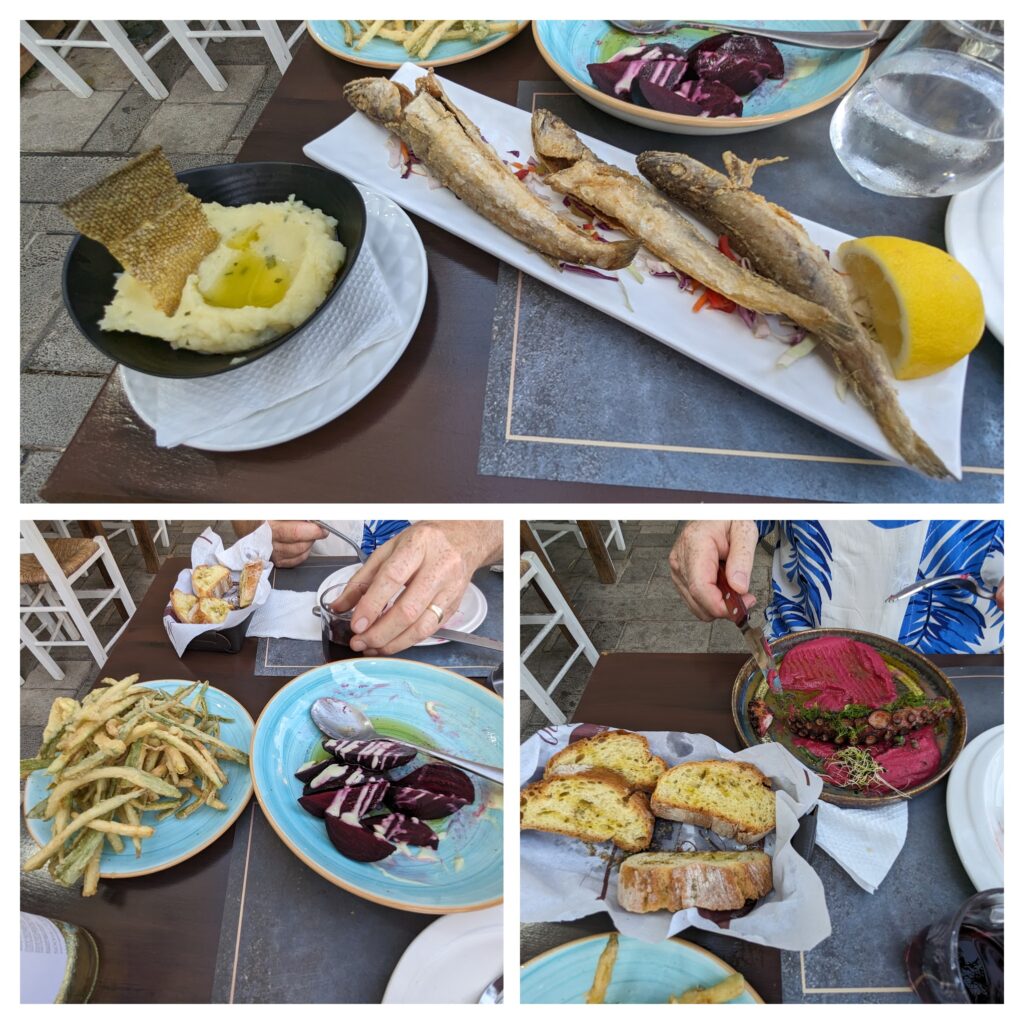 Seafood of course! Fried cod (baby cod I think), grilled octopus (one thick tentacle), fried zuchinni and roasted beets!
Seafood of course! Fried cod (baby cod I think), grilled octopus (one thick tentacle), fried zuchinni and roasted beets!
May 31 Turkey to Greece (Day 247)
We were up early this morning, finishing packing and eating leftovers for breakfast before our driver arrived to take us to the ferry port in Çeşme, an hour’s drive away. The ferry will take us across the border into Greece, only a half hour away, to the Greek island of Chios (pronounced Hee-ose).
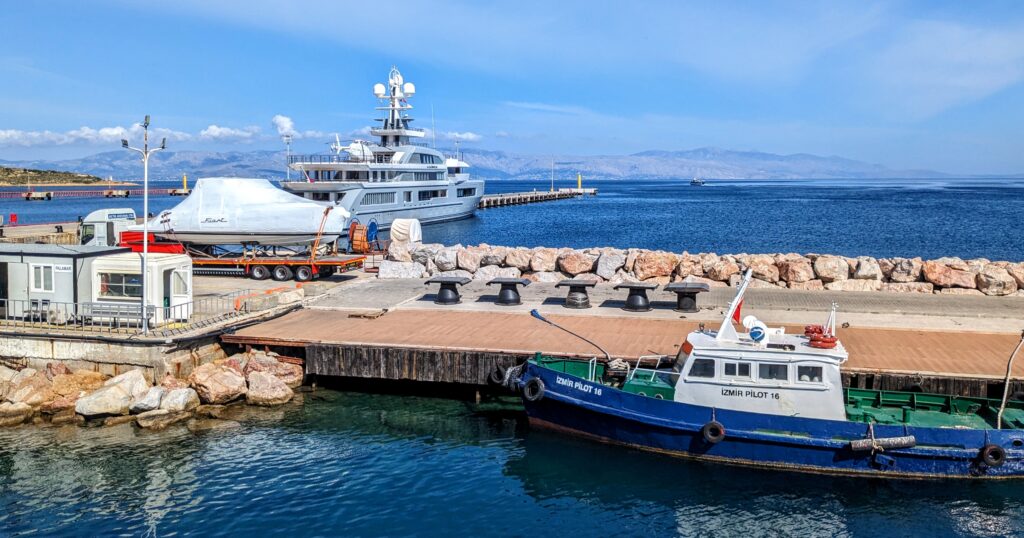
Finally onboard the ferry, after 2 passport checks and baggage x-rays, we spotted this megayacht docked nearby, with a helicopter on board! I looked it up later, it’s the Cloudbreak, and it’s available for charter!

Disembarking in Chios, the ferry looked bedraggled compared to the megayacht docked back in Turkey!
We made our way through town and found our Airbnb, a penthouse studio apartment with a huge rooftop terrace!

From the terrace we have a view overlooking a church, and looking opposite, a view of town and the mountains in the background.
We partially unpacked, we will be here only 2 nights, then set out to explore the town, Chios City. We headed back to the port and found a car rental agency that we can rent a car from for tomorrow’s exploration further afield, then we wandered into the old part of the city, aiming for the bell tower of a church. We came upon the “Holy Church of Saint George at the Castle of Chios“, a Greek Orthodox church. In the overgrown weedy yard we found cannons with the dates 1687 and 1689 on them!

It was early evening, so we weren’t able to enter the church, but you can see the interior in the above link.
Wandering further into the narrow lanes paved with stone, ancient stone buildings on either side, some in disrepair, some being restored, feeling lost with all the angles askew, we climbed a weedy stone stairway…
…and discovered that we were on top of the city wall! We climbed down and made our way out of the maze to marvel at the stone city walls and the gate we finally found!

The city has expanded beyond these walls of course, but back in medieval times this must have been the sanctuary people fled to in times of attack!
We headed back to our apartment and enjoyed the food that our host provided to us; delicious ripe tomatoes, crusty bread, feta cheese, olive oil, lemonade syrup, lemons, a variety of homemade jams, fresh cream with fruit compote and a whole melon!
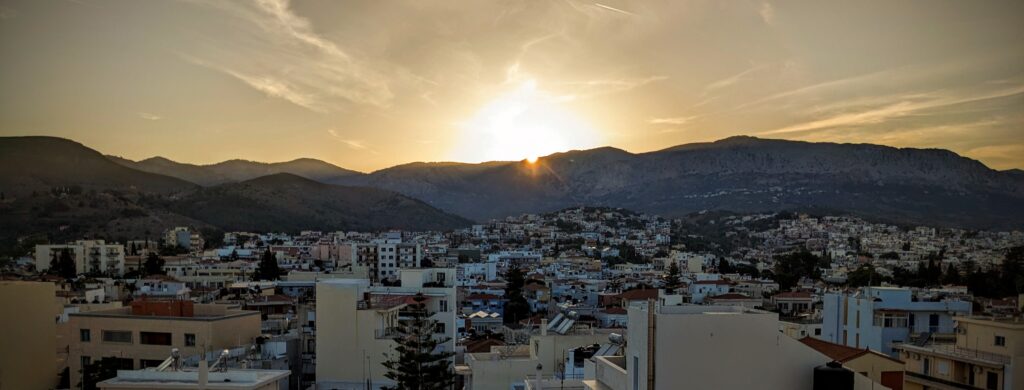
We enjoyed our simple meal while we watched the sun set behind the mountains.
May 30 Art & History (Day 246)
Today I hunted down the Arts & History Museum which has been housed various places in Izmir until just last year when a new complex was opened in the renovated old Tobacco warehouses north of Kulturpark. This may be the tobacco warehouses where Linda mentioned she went to school back in the 60’s. The new complex, “the İzmir Kültür Sanat Fabrikası (the Izmir Culture and Arts Factory) which includes the Archaeology and Ethnography Museum, the İzmir Painting and Sculpture Museum, the Atatürk Special Library, the Alsancak Public Library and the Turkic World Music Special Library, as well as cultural and art workshops, an open-air cinema, exhibition areas and a spacious green area, opened its doors to visitors in April 2023.” When I arrived at about 10:30am the campus was filled with young people, students I surmised, there for the workshops on art, music and dance. I headed in to the Archaeology and Ethnography Museum, which was almost empty of people, and was overwhelmed with the artifacts and history presented.

The first exhibit I saw is this one on the strategic position of Izmir in the ancient world, a crossroads of trade across the European waterways and linking Asia with Europe. The many clay vessels (found from shipwrecks it looks like) transported olive oil, wine and other commodities throughout the area.

Much smaller, delicate glass bottles transported fine oils, perfumes and cosmetics!

The hall of sculpture consisted of several rooms. These heads show the variety of poses and facial features and the skill of the carvers.

This statue stood out for it’s more primitive design, besides missing the head and arms! It is a statue of Artemis Ephesia, and exemplifies the differences between the European (Artemis, the Archer Goddess, depicted as a young athletic woman) and the Asian or Anatolian (Artemis Ephesia, the Mother Goddess, depicted with a dress adorned with animals & breast/testicle reliefs).
“In Greek mythology, Artemis is the daughter of Leto and Zeus and the sister of Apollo. Artemis appears in two different forms. One of them is the “Archer Goddess” Artemis, which reflects the Greek interpretation, and the other is Artemis Ephesia, the goddess of abundance and fertility, whose origins go back to the Mother Goddess of Anatolia, Cybele, and finally take shape in Ephesus. The Archer Goddess is depicted with her short dress (Khiton), quiver, and bow. Artemis Ephesia, on the other hand, is depicted with her archaic stance that goes back to the depths of history, her layered crown, her deep gaze, her dress adorned with animals, the breast/testicle reliefs overflowing from her chest, and her arms reaching forward as if embracing a person. Artemis is both a girl, a woman, and a mother.”

Fine jewelry on display. There are also lifesized models of the workshops where many types of artifacts were manufactured such as oil lamps, clay figurines, clay vessels, jewelry, sculptures, etc.
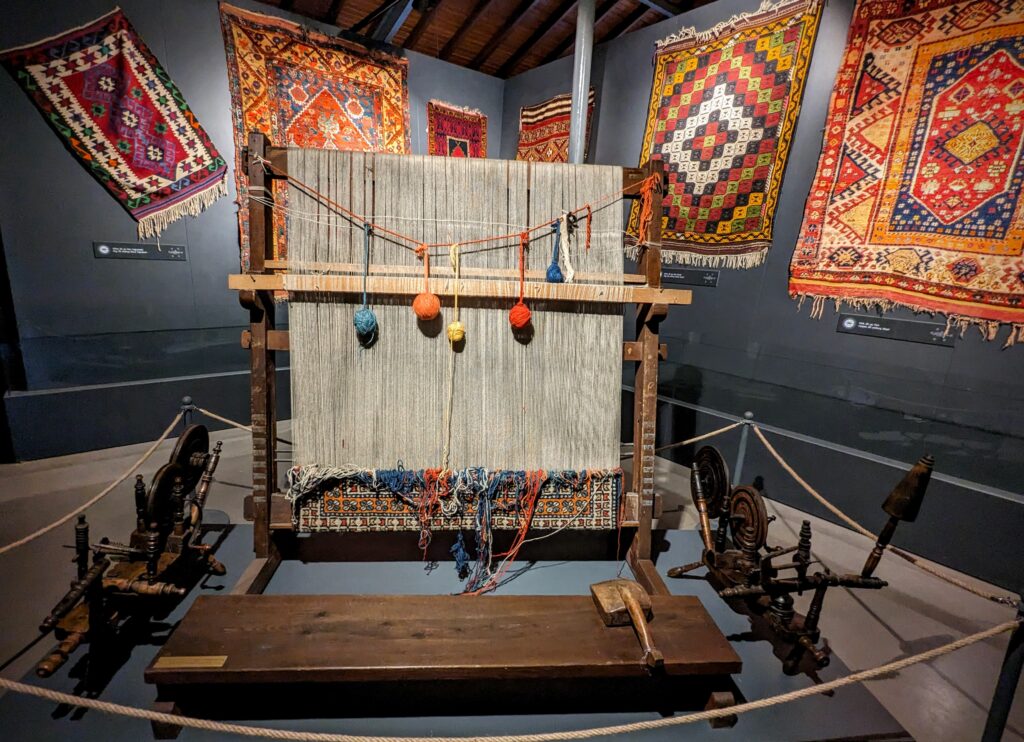
Another exhibit displayed the textile arts, with embroidery and rug weaving prominent.
The Museum had displays from the neolithic time to the War of Independence of 1922 but I didn’t see anything displaying information about the Ottoman Empire (approximately 1400’s to WW1) except this;

“The Conquest of Constantinople”, by who, as if we don’t know. Why don’t they display that history?
After my museum experience I walked to the waterfront and back to the tram station, returned to ‘our’ neighborhood, did some shopping and took the elevator up the hill and walked the 15 minutes to the apartment. Robert was nursing a sore knee from all the stairs and hill climbing!
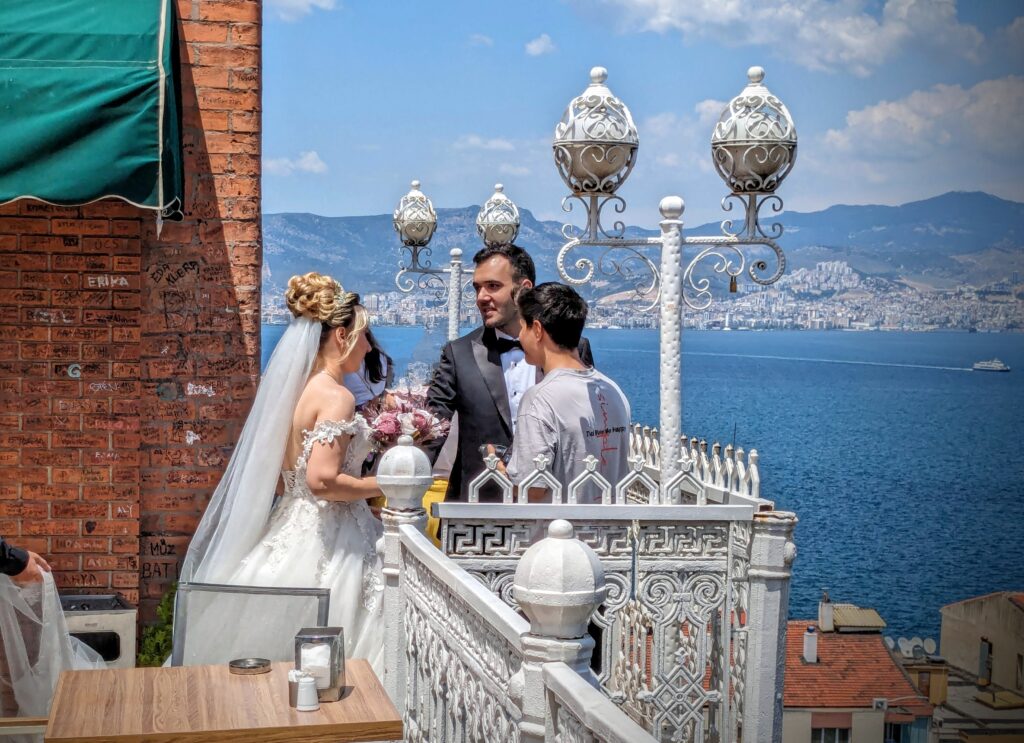
Up at the top of the elevator a wedding party was positioning to get photos with the backdrop of the bay!
May 29 Old Smyrna (Day 245)
Our adventure today was visiting the Agora of Old Smyrna, the Greek city established here by Alexander the Great in the 2nd century A.D. We took the tram and stopped at the Izmir Clock Tower and visited the tiny mosque built nearby.

It has beautiful blue tilework!
We headed into the labyrinth of the Kemeralti Market to get across and to the archaeological site of the old city marketplace. We finally found the entrance and started exploring the basement of the complex.

Heading down to the cooler basement!

Ancient graffiti has been found in the tunnels, pictures of ships and fighting gladiators from Roman times!
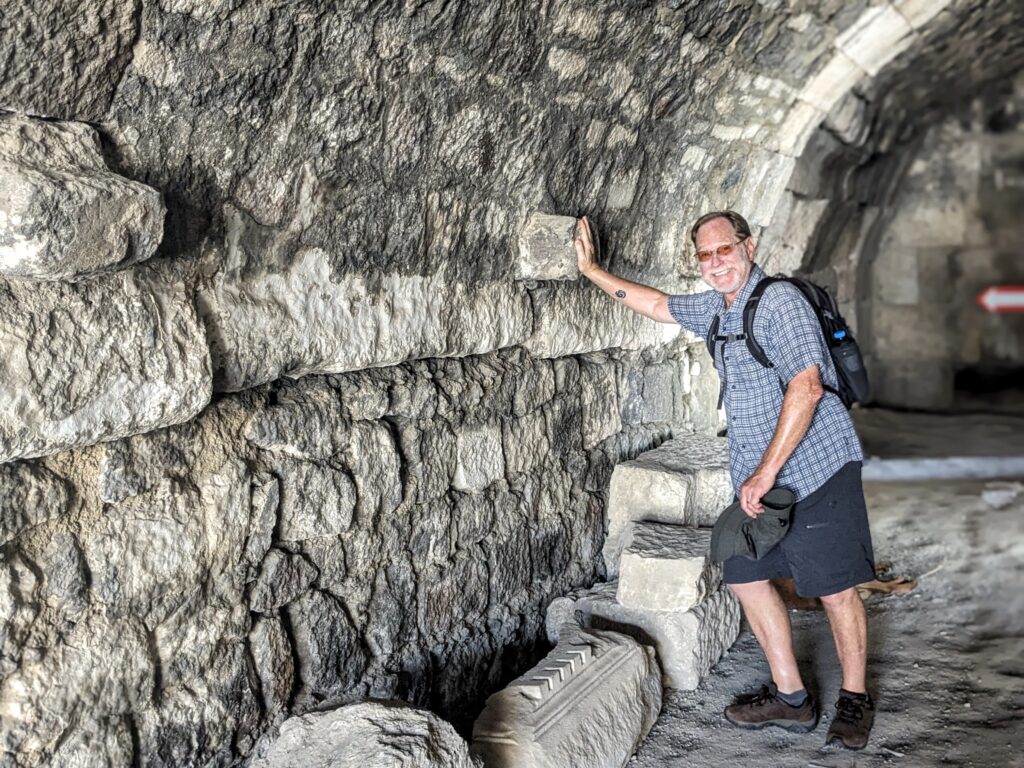
If Robert pushes any harder on that stone a huge boulder might come rolling at us!
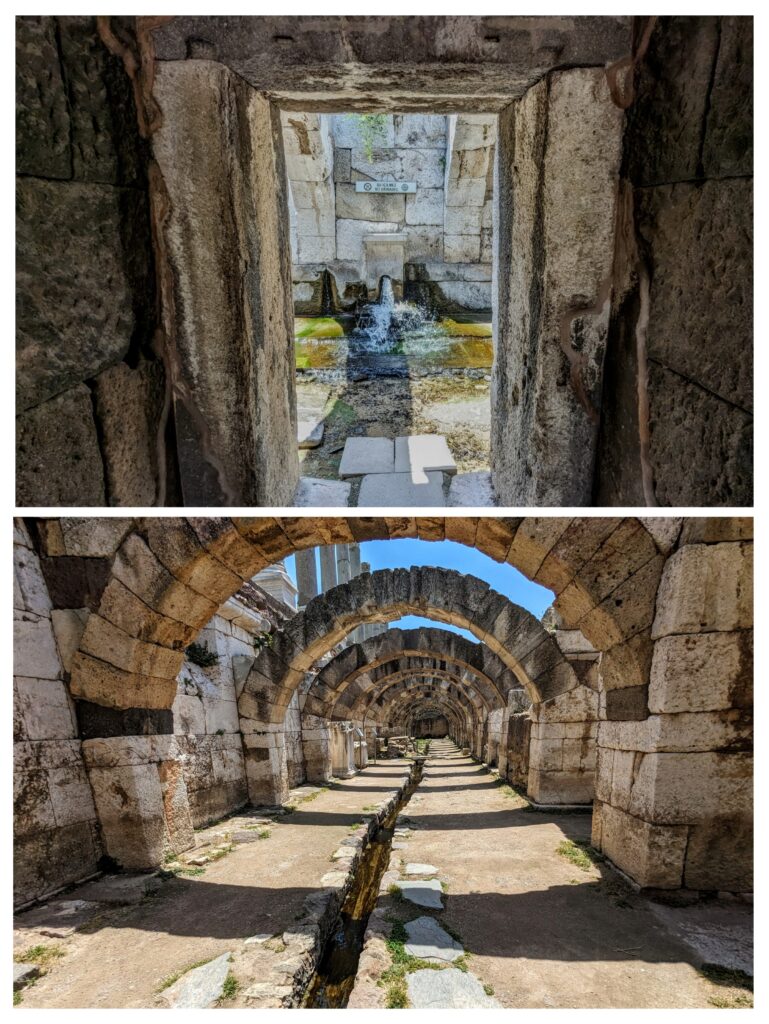
Surprisingly there is a gushing fountain and a series of channels moving water throughout the complex!
“Water channels big enough for a person to pass easily through them have been identified beneath the modern city within the agora and south of it. Today water from an unidentified source still flows through these channels; it is understood that they were used from the Roman period down to Ottoman times. The water flowing from the terracotta pipe here comes from the above-mentioned channels. In Late Antiquity the water was stored in cisterns and used in workshops in the agora.” Roman engineering still working!

Above the basements were the plazas and administrative buildings.
We headed back to the tram and on to the Atatürk Museum in the mansion of a Greek rug merchant who fled Izmir during the War of Independence in 1922. Atatürk used the building as a headquarters during the War and as a residence when he visited Izmir.
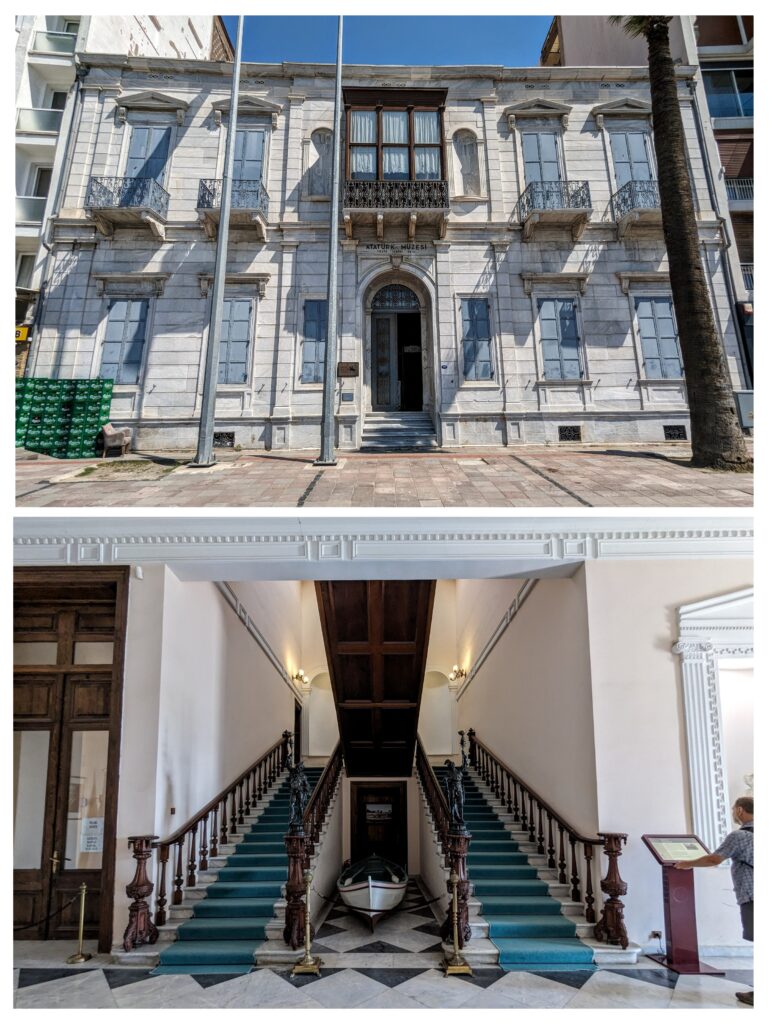
The exterior and interior.
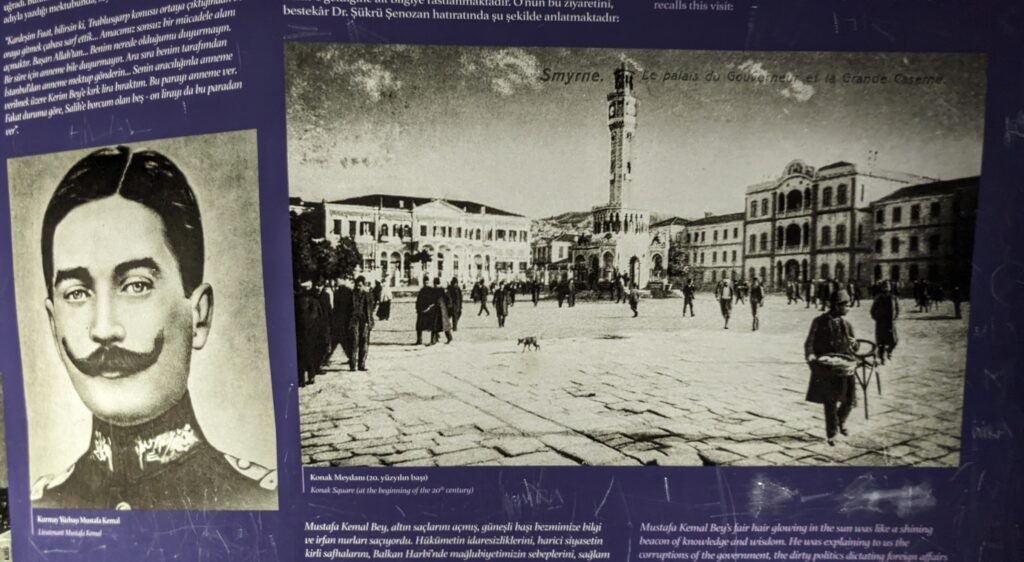
Photo of a young Mustafa Kemal before being bestowed the surname Atatürk after the War of Independence.
We took the tram back to our neighborhood and walked to the famous historic elevator and took it up to avoid trudging up the many stairs! 

The view from the top!

And another beautiful sunset from the rooftop terrace!
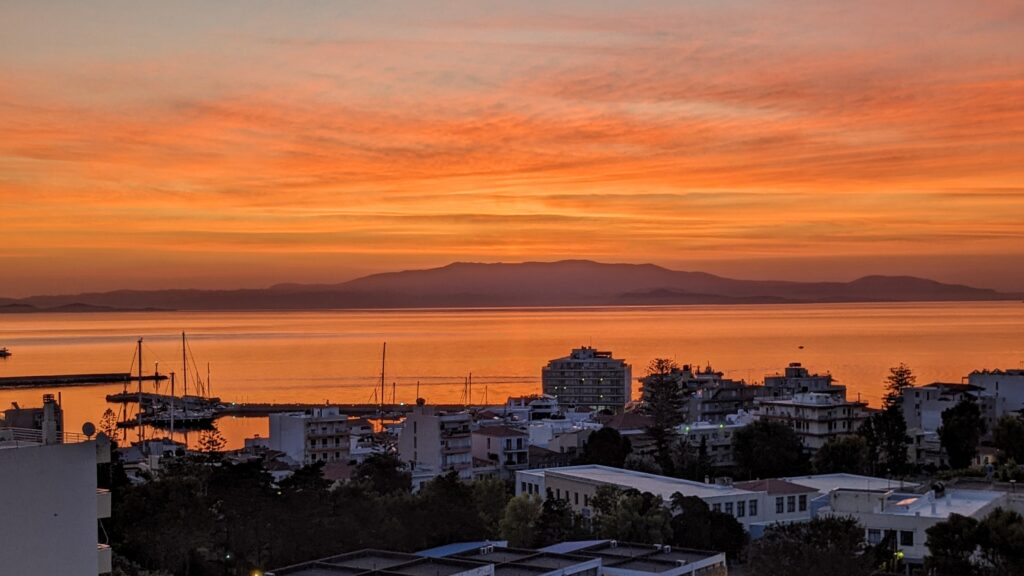
 Our ferry arrived on time and we boarded for a long ride, almost 9 hours and several stops before our destination on the island of Syros.
Our ferry arrived on time and we boarded for a long ride, almost 9 hours and several stops before our destination on the island of Syros. I lost track of our progress and the ports we stopped at, but there were several green islands with trees…
I lost track of our progress and the ports we stopped at, but there were several green islands with trees… …and brown islands with rocks!
…and brown islands with rocks!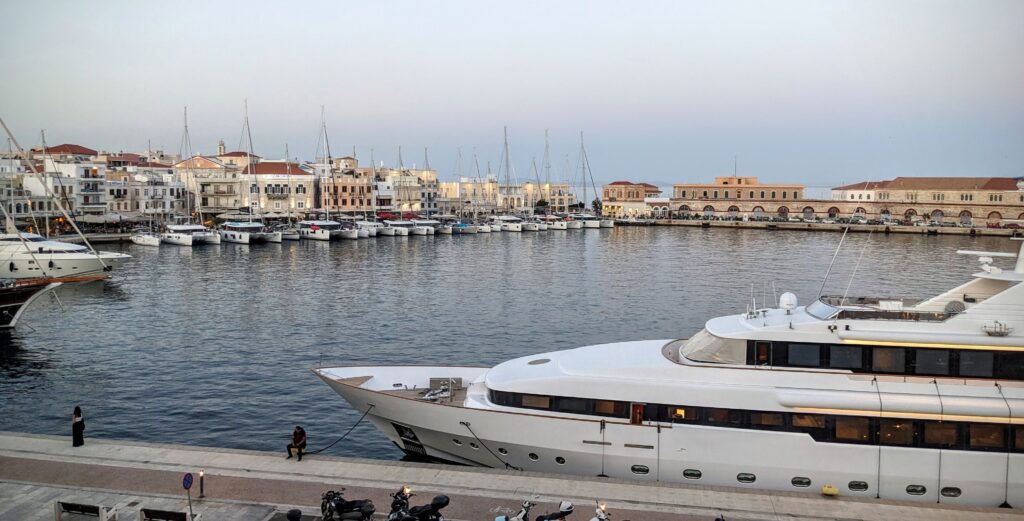 We finally reached our destination of Ermoupolis, Syros after 8pm. We found our lodging, not too far from the disembarkation point and immediately went up to the rooftop terrace for the view of the megayacht docked right in front!
We finally reached our destination of Ermoupolis, Syros after 8pm. We found our lodging, not too far from the disembarkation point and immediately went up to the rooftop terrace for the view of the megayacht docked right in front! As the sun faded the city lights came on, illuminating the many sailboats docked at the waterfront, including the wooden 3 masted schooner that came in shortly after we arrived.
As the sun faded the city lights came on, illuminating the many sailboats docked at the waterfront, including the wooden 3 masted schooner that came in shortly after we arrived.



 The museum is the ossuary of the bones of some of the victims of the
The museum is the ossuary of the bones of some of the victims of the  The Turks attacked the church and burned it to the ground with all inside. The floor is the only original part of the church and is said to be stained with the blood and flesh of the victims burned alive.
The Turks attacked the church and burned it to the ground with all inside. The floor is the only original part of the church and is said to be stained with the blood and flesh of the victims burned alive. We sought out a more peaceful venue after that history lesson!
We sought out a more peaceful venue after that history lesson! We continued to a more ancient site at Emporio, an archaeological site dating from the 8th century B.C. overlooking the small port. The cultivated fields are mostly orchards of mastic trees, a unique agricultural phenomenon practiced only on the south part of Chios island. We continued south, to the southernmost beach, Vroulidia (or Broulidia, depends on what map you’re looking at I guess).
We continued to a more ancient site at Emporio, an archaeological site dating from the 8th century B.C. overlooking the small port. The cultivated fields are mostly orchards of mastic trees, a unique agricultural phenomenon practiced only on the south part of Chios island. We continued south, to the southernmost beach, Vroulidia (or Broulidia, depends on what map you’re looking at I guess).




 Seafood of course! Fried cod (baby cod I think), grilled octopus (one thick tentacle), fried zuchinni and roasted beets!
Seafood of course! Fried cod (baby cod I think), grilled octopus (one thick tentacle), fried zuchinni and roasted beets!
























